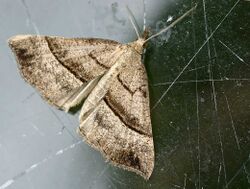Biology:Hypeninae
From HandWiki
Short description: Subfamily of moths
| Hypeninae | |
|---|---|

| |
| The snout, Hypena proboscidalis | |
| Scientific classification | |
| Domain: | Eukaryota |
| Kingdom: | Animalia |
| Phylum: | Arthropoda |
| Class: | Insecta |
| Order: | Lepidoptera |
| Superfamily: | Noctuoidea |
| Family: | Erebidae |
| Subfamily: | Hypeninae Herrich-Schäffer, [1851] |
The Hypeninae are a subfamily of moths in the family Erebidae. The taxon was first described by Gottlieb August Wilhelm Herrich-Schäffer in 1851.[1] A notable species is Mecistoptera griseifusa, which lives solely on tears it drinks with its proboscis.
Taxonomy
The subfamily was previously classified in the family Noctuidae. Several genera that were previously classified in the subfamily have been moved to the Rivulinae and Boletobiinae subfamilies of Erebidae, leaving the Hypeninae as a group of genera closely related to the type genus Hypena.[2][3]
Genera
- Aethalina
- Arrade
- Artigisa
- Avirostrum
- Britha
- Calathusa
- Catada
- Catadoides
- Colobochyla
- Dichromia
- Elaphristis
- Epitripta
- Esthlodora
- Foveades
- Goniocraspedon
- Goniophylla
- Harita
- Hypena
- Hypenarana
- Hypertrocta
- Lophotoma
- Lysimelia
- Mecistoptera
- Meyrickella
- Naarda
- Panilla
- Paonidia
- Parilyrgis
- Paurophylla
- Pherechoa
- Philogethes
- Prionopterina
- Rhodina
- Rhynchina
- Rhynchodontodes
- Sandava
- Sarobela
- Stenopaltis
- Synolulis
- Tigrana
References
- ↑ Savela, Markku (August 2, 2019). "Hypeninae Herrich-Schäffer, [1851"]. https://www.nic.funet.fi/pub/sci/bio/life/insecta/lepidoptera/ditrysia/noctuoidea/erebidae/hypeninae/.
- ↑ Fibiger, Michael; Lafontaine, J. Donald (June 29, 2005). "A review of the higher classification of the Noctuoidea (Lepidoptera) with special reference to the Holarctic fauna". Esperiana 11: 7–92.
- ↑ Zahiri, Reza (2011). "Molecular phylogenetics of Erebidae (Lepidoptera, Noctuoidea)". Systematic Entomology 37: 102–124. doi:10.1111/j.1365-3113.2011.00607.x.
Wikidata ☰ Q1795004 entry
 |

